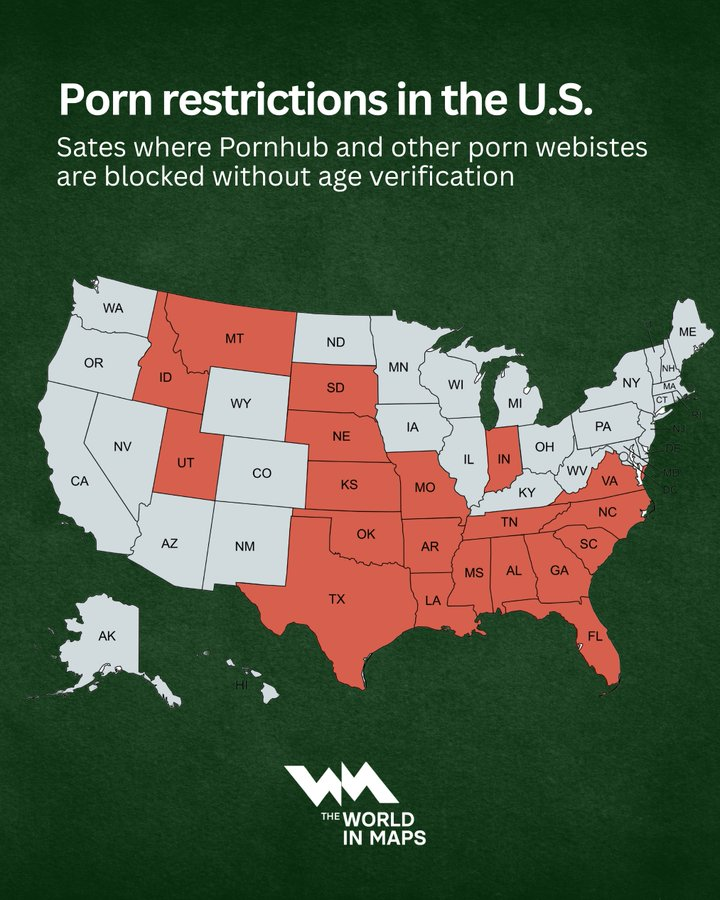Pornhub Age-Verification Laws Map in US States


Marcus Rodriguez
Historical Geography Expert
Marcus Rodriguez specializes in historical cartography and geographic data analysis. With a background in both history and geography, he brings unique...
Geographic Analysis
What This Map Shows
This map illustrates a significant shift in digital access, highlighting the 21 U.S. states that have enacted age-verification laws, leading to restrictions on access to Pornhub within their jurisdictions. This visualization provides a clear overview of the geographical landscape of these legislative changes, showcasing how widespread this phenomenon has become in the United States. With over a third of the states now covered by these laws, the implications for internet access and personal privacy are profound.
Deep Dive into Age-Verification Laws
Age-verification laws are designed to restrict access to adult content online by requiring websites to verify the age of their users. The objective is to protect minors from exposure to inappropriate material. However, the implementation of these laws raises several questions about privacy, accessibility, and the balance between regulation and freedom of information.
Interestingly, the states that have adopted these laws vary widely in their political and cultural landscapes. For instance, states like Utah and Louisiana have taken measures that reflect their conservative values, where there is a significant emphasis on protecting children from explicit content. According to the National Conference of State Legislatures, the push for such laws gained momentum as concerns about children's online safety increased, particularly during the COVID-19 pandemic when screen time soared.
The intricacies of how age verification systems work also play a crucial role in the discussion. Many systems rely on government-issued identification, while others may utilize third-party verification services. This introduces potential risks to user privacy, as individuals may be required to share sensitive information to gain access to content. It's worth noting that critics argue this could lead to data breaches and misuse of personal data.
The implementation of these laws is not uniform. Some states have more stringent requirements than others, leading to a patchwork of regulations across the country. For example, Alabama and Arkansas have enacted laws that impose hefty fines on websites that do not comply with age verification processes, while other states may have less severe consequences. This inconsistency can create confusion for both users and content providers, raising concerns about the fairness of access to digital content.
Regional Analysis
Breaking down the map regionally reveals interesting trends. In the West, states like Utah and Idaho have enacted strict regulations, aligning with their cultural values that prioritize family and child protection. Conversely, states in the Northeast, such as New York and Massachusetts, have not yet adopted similar laws, reflecting a more liberal approach towards adult content. The Midwest shows a mixed landscape; for instance, Ohio has enacted age-verification laws, while neighboring states like Indiana have not, which can lead to disparities in digital access across state lines.
Interestingly, some southern states have taken a leading stance in this movement. Louisiana's law is particularly noteworthy for its aggressive enforcement measures, including the potential for criminal penalties against site operators. This reflects a broader trend in southern states where there is often a stronger push for regulatory measures that align with conservative social values. In contrast, the West Coast, known for its progressive stance on many issues, has remained largely silent on age verification laws, suggesting a potential clash between technological freedom and social conservatism.
Significance and Impact
The significance of these age-verification laws extends beyond the realm of adult content access; they touch on broader themes of digital rights and privacy. As more states implement these regulations, the implications for internet freedom become increasingly complex. Advocates argue that these laws are necessary for protecting minors, while opponents contend that they infringe on individual rights and create barriers to information.
Moreover, the trend of enacting age-verification laws may signal a growing movement towards increased regulation of the internet. As technology continues to evolve, the balance between safety and freedom will be an ongoing debate. Current projections suggest that we may see more states consider similar measures in the near future, particularly as public discourse around online safety and data privacy intensifies.
In conclusion, the landscape of adult content accessibility in the U.S. is shifting dramatically due to age-verification laws, as shown in this map. Understanding the geographical variations and implications of these laws is crucial for anyone interested in the intersection of geography, policy, and digital rights. The future of internet access may hinge on how these regulations develop and how states choose to approach this complex issue.
Visualization Details
- Published
- August 12, 2025
- Views
- 482
Comments
Loading comments...